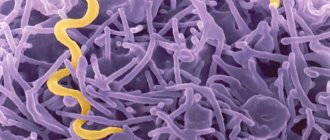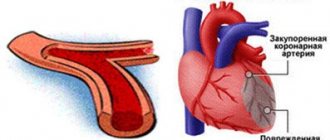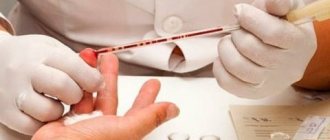Syphilis test RPR – a screening test used to detect syphilitic infection.
It can also be used to monitor the effectiveness of treatment.
Rapid Plasma Reagin is a non-treponemal laboratory test.
The technique is aimed at detecting antibodies in the blood that are formed in reagin antigens.
Antibodies are immunity factors.
They are formed by interaction with certain antigens.
Most often, these antigens contain pathogenic bacteria or viruses.
In addition, it is possible that autoantigens may form in the body itself during tissue breakdown.
Reagins are human own antigens.
They are often formed as a result of infection with syphilis.
Therefore, the detection of antibodies to these antigens gives reason to at least suspect a syphilitic infection.
In the future, additional studies are carried out to confirm or refute the diagnosis.
When is the RPR syphilis test taken?
RPR is mainly given for the following indications:
- mass examination for syphilis of patients who do not have symptoms of this disease (during hospitalization in a hospital, before operations, at the stage of pregnancy planning, etc.);
- examination of representatives of decreed professions (food, water industry, work in children's groups and the healthcare system);
- examination of patients with sexually transmitted infections infected from an unknown source;
- unprotected sexual contact with a carrier of syphilitic infection.
RPR can be used to establish a diagnosis in patients with symptoms of syphilis.
But only in combination with treponemal confirmatory tests.
Similarly, RPR can be used to screen donors of blood, internal organs, or germ cells.
License
Syphilis began to be detected at the end of the 15th century. The disease is characterized by a complex course and varied clinical picture, which is due to the characteristics of the pathogen (Treponema pallidum) and the immunological response of the body. The pathogenesis of syphilis has much in common with the pathogenesis of tuberculosis. Both diseases are caused by slowly reproducing pathogens that are resisted by cellular immunity. Both syphilis and tuberculosis begin with a primary focus of infection, followed by asymptomatic bacteremia with dissemination of the pathogen to other organs. Both diseases are characterized by granulomatous inflammation during reactivation of infection, which usually occurs when the immune system is weakened.
Traditionally, primary, secondary and tertiary syphilis are distinguished. However, sometimes the differences between the stages of syphilis become blurred. For example, neurosyphilis, which is usually classified as tertiary syphilis, also occurs in early forms of syphilis. For syphilis in HIV-infected people, the ineffectiveness of conventional treatment, atypical results of serological reactions, as well as a high risk of neurosyphilis have been described.
In the United States, the incidence of early syphilis (primary, secondary, and early latent) has fluctuated greatly over the past 50 years. In the 70s and early 80s. The 20th century saw an increase in the incidence of early syphilis, mainly due to the high incidence among homosexuals and bisexual men. However, since the mid-80s. In the 20th century, the incidence of early syphilis among homosexuals and bisexual men fell sharply, which is associated with cautious sexual behavior in this group due to the risk of HIV infection. At the end of the 80s. In the 20th century, the incidence of early syphilis began to increase again, mainly due to heterosexual individuals. This is associated with the spread of drug addiction and increased social inequality. During the 92s of the 20th century, the incidence of early syphilis in the United States decreased to the lowest rates for the entire period of registration of this disease. In 1999, the Centers for Disease Control (CDC) announced plans to completely eliminate syphilis in the United States. However, from 1998 to 2000, a number of states reported an increase in the incidence of early syphilis among gay and bisexual men, many of whom were HIV-infected. This fact and the cyclical nature of the incidence create the danger of a new increase in the incidence of early syphilis in the United States.
Epidemiology
Morbidity
In 1998, there were 6,993 cases of early syphilis reported in the United States, or 2.6 people per 100,000 population. This is the lowest rate for the entire period of registration of syphilis. 78% of counties reported no cases of syphilis in their area in 1998.
Routes of infection
Sexual transmission of infection is characteristic of early syphilis (primary, secondary and early latent). Congenital syphilis is caused by transplacental infection of the fetus during pregnancy. Cases of non-sexual infection with syphilis are rare and sometimes occur in hospital settings.
Age
The disease occurs at any age. People aged 21-34 years are most often affected. Moreover, the average age of patients with syphilis is higher than the average age of patients with gonorrhea and chlamydial infection. Late syphilis is often detected in old age.
Floor
The distribution of syphilis among men and women depends on the proportion of homosexuals and the prevalence of prostitution in a given population. If we talk about registered cases of syphilis, they occur somewhat more often in men than in women.
Sexual orientation
Syphilis among homosexual and bisexual men is usually associated with casual sex, most often in saunas, etc. The disease is rare among lesbians.
Other risk factors
Drug addiction, prostitution, low social and educational level, other risk factors and markers of STDs.
Clinical picture
Epidemiological history
In most cases of early syphilis, information about a new sexual partner, casual sexual intercourse, especially with strangers or prostitutes is revealed.
Incubation period
From the moment of infection to the development of primary syphilis, it usually takes 2-6 weeks (sometimes up to 3 months).
Clinical examination
PRIMARY SYPHILIS
A chancre is a painless or slightly painful ulcer of a round or oval shape with a hard base. The bottom of the ulcer is usually clean. Chancroid is an optional, but very specific symptom of primary syphilis. In most cases, the external genitalia are affected. However, chancre often occurs on the vaginal mucosa, in the perianal area, and less often on the oral mucosa. It is usually accompanied by enlargement of regional lymph nodes, often bilateral. The lymph nodes are dense, painless, the skin over them is not changed. There are usually no general symptoms with primary syphilis. An asymptomatic course of primary syphilis is possible, which may be due to undetected chancroid (in the rectum, in the vagina). Possibly an atypical course.
SECONDARY SYPHILIS
The clinical picture of secondary syphilis is multifaceted. The most common type is a widespread, nonpruritic papular-squamous rash affecting the palms and soles. Atypical rashes, including itching, are possible. Other common manifestations of secondary syphilis are painless plaques on the mucous membranes, condylomas lata, small focal syphilitic alopecia, generalized lymphadenopathy, fever, headache, and weakness. Neurological disorders, mainly damage to the cranial nerves, are possible.
TERTIARY (LATE) SYPHILIS
Tertiary syphilis is now rare. Its typical manifestations are foci of granulomatous inflammation (gumma of the skin, liver, bones and other organs); damage to the central nervous system (tabes dorsalis, progressive paralysis and dementia) and damage to the cardiovascular system (syphilitic aortitis, aortic aneurysm, aortic insufficiency).
LATENT SYPHILIS
Latent syphilis is syphilis in which serological reactions are positive in the absence of other manifestations of the disease. There are early (less than 1 year from the onset of the disease) and late (more than 1 year from the onset of the disease) latent syphilis.
CONGENITAL SYPHILIS
The severity of congenital syphilis can vary from asymptomatic to fatal. The most common early manifestations of congenital syphilis are spontaneous abortion, stillbirth, encephalitis, widespread rash, syphilitic rhinitis, liver damage, disseminated intravascular coagulation, and multiple organ failure. Late manifestations of congenital syphilis include osteitis of the long bones, bone and dental malformations, keratitis, sensorineural hearing loss, and neurological disorders.
Laboratory research
Identification of the pathogen
It comes down to identifying Treponema pallidum itself or its antigens. The diameter of Treponema pallidum is less than the resolution of a light microscope. Therefore, to detect it, dark-field microscopy, phase-contrast microscopy, special stains (for example, the silver method) and immunological methods (for example, the direct immunofluorescence method) are used.
DARK-FIELD MICROSCOPY
The result of the method is considered positive when motile spirochetes 10-13 microns long are detected in the exudate of chancre, elements of the rash in secondary syphilis and the contents of the lymph nodes. The number of curls is approximately one per 1 micron. Treponema pallidum perform characteristic movements - they rotate around their own axis and fold like a penknife. The method is not informative when studying material from the oral mucosa, since the normal microflora of the mouth includes other spirochetes.
IMMUNOLOGICAL METHODS AND METHODS OF DNA AMPLIFIATION ANALYSIS
Direct immunofluorescence using polyclonal antibodies is a specific and moderately sensitive method that can replace dark-field microscopy. There are more specific and sensitive methods - the immunofluorescence method using monoclonal antibodies and the polymerase chain reaction. However, at present they are not widely used.
HISTOLOGICAL STUDIES
The silver method and immunofluorescence staining are used to detect Treponema pallidum in tissues. These methods are characterized by low sensitivity but high specificity.
Serological studies
Serological tests in most cases are the basis for diagnosing syphilis.
NON-TREPONEMAL REACTIONS
The cardiolipin antigen inactivated serum precipitation reaction (VDRL) and the cardiolipin antigen plasma precipitation reaction (RPR) detect antibodies to cardiolipin antigen (lipids that are part of the cell wall of Treponema pallidum). Non-treponemal reactions are characterized by high sensitivity, but low specificity. Their positive result requires confirmation by treponemal reactions.
Non-treponemal reactions are used: (1) for mass examinations; (2) to determine the activity of the pathological process. VDRL and RPR become positive during the primary period of syphilis. They are positive in approximately 70% of patients with primary syphilis. At the end of the primary period of syphilis, they are positive in almost all untreated cases. The titer of non-treponemal reactions is maximum (from 1:16 to 1:256) in the secondary period of syphilis. After the completion of the secondary period of syphilis, the titer of non-treponemal reactions decreases independently in the absence of treatment (for example, with untreated late latent syphilis, the titer of non-treponemal reactions is usually from 1:1 to 1:8). With tertiary syphilis, the titer of non-treponemal reactions increases again. After complete treatment, the titer of non-treponemal reactions gradually decreases. After treatment of primary and secondary syphilis, the titer of non-treponemal reactions decreases by 2 or more dilutions (for example, from 1:16 to 1:4) within 3 months. In more than 90% of patients with early syphilis, non-treponemal reactions are negatived within 12 months after treatment. In contrast, in late syphilis they often remain positive at a low titer (usually 1:1 to 1:2) for a long time. False-positive results of non-treponemal reactions occur (usually in a titer of 1:8 and lower). Causes of false-positive results include pregnancy and autoimmune diseases.
TREPONEMAL REACTIONS
These reactions reveal antibodies to a specific treponemal antigen. Treponemal reactions include immunofluorescence-absorption test (FTA-ABS), micromodification of passive hemagglutination test (MHA-TP) and others.
The titer of treponemal reactions does not reflect the activity of the pathological process. They will be used to confirm positive results of non-treponemal reactions (VDRL and RPR). After treatment of secondary and tertiary syphilis, treponemal reactions remain positive for an indefinite period. After treatment of primary syphilis, they are negative in 25% of cases. If the result of treponemal reactions is positive, there is no need to repeat them. To monitor the effectiveness of treatment, only quantitative non-treponemal reactions are used. On the other hand, there is no need to prescribe treponemal reactions if the result of non-treponemal reactions is negative, with the exception of primary syphilis.
Diagnostics
Diagnosis of primary and secondary syphilis is largely based on the clinical picture; serological reactions only confirm the diagnosis. In contrast, the diagnosis of latent and late syphilis is mainly based on serological tests. The diagnosis of syphilis should be considered doubtful if the result of treponemal reactions is negative, with the exception of the early stage of primary syphilis.
Although doctors of other specialties rarely encounter syphilis, mass examinations for syphilis using non-treponemal reactions are expensive and worthwhile. When positive results are confirmed by treponemal reactions, the likelihood of false positive results is low. Mass screenings are indicated in areas with high prevalence and risk groups for syphilis.
CSF STUDY
Neurosyphilis is the most common complication of syphilis, often asymptomatic. CSF examination is the main method for diagnosing neurosyphilis. Indications for CSF examination include neurological symptoms in patients with any stage of syphilis, as well as the ineffectiveness of conventional treatment due to repeated dissemination of Treponema pallidum from the CSF. In patients with infection duration of more than 1 year, indications for CSF examination include: VDRL or RPR titer more than 1:32; HIV infection; prescription of reserve antibiotics.
Prevention
It is necessary to examine (including serological tests for syphilis) all partners who had sexual contact with the patient during the infectious period of the disease (from the moment of infection to the start of treatment). Treatment has been indicated for sexual partners over the past 3 months, regardless of the results of serological tests.
Mass surveys
Conducted in risk groups. Most US states conduct mass screenings of pregnant women.
Reporting
Carried out in accordance with the laws of each state. Reporting every case of syphilis is essential for accurate statistics that will allow for the proper allocation of resources and prevention programs. Cases of early syphilis are reported urgently by telephone to local health authorities.
Hunter Handsfield
Sexually transmitted diseases. Color atlas reference book. – M.: “Publishing house BINOM”, 2006.-296 p.: ill.
pp.58-63, 66
Sensitivity of the RPR syphilis test
RPR is a highly sensitive diagnostic test.
It is for this reason that it is used as a selection reaction.
In mass laboratory testing of people for syphilis, there is nothing to worry about that some patients will get a false positive result.
Because in the future, you still need to confirm the diagnosis with other methods.
As a result, all false positive results will be eliminated.
But if a false negative result is obtained, the consequences are much more serious both for the person himself and for those around him.
A patient suffering from syphilis who receives a negative result goes home and is not treated.
He does not know about his disease, so he continues to be sexually active, infecting his partners.
The patient himself also suffers, because the syphilitic infection progresses.
Therefore, high sensitivity is most in demand for selection reactions.
It is important not to miss a single case when a person may be infected with syphilis.
RPR has 100% sensitivity in the secondary stage of the disease.
In the primary stage, the test gives positive results in 70-80% of situations.
However, the specificity of RPR is low.
As we have already said, the technique is based on the detection of reagin antibodies.
That is, those that are formed to their own, and not treponemal antigens.
The same antibodies may appear in the blood in some other diseases.
The RPR test result may then be a false positive.
Therefore, each case of a positive reaction is double-checked using other serological tests.
Diagnosis of syphilis
Serological diagnosis of syphilis
Diagnosis of syphilis is based on clinical and laboratory data. The diagnosis of syphilis is made only after laboratory confirmation, i.e., detection of pale treponema in chancroid discharge, erosive papules in primary and secondary syphilis, and serological examination data. Serological reactions are an extremely valuable method not only for confirming the diagnosis of syphilis, but also for monitoring the dynamics of its course under the influence of treatment and determining whether the disease is cured.
The standard components of the complex of serological reactions (CSR) for ascertaining a syphilitic infection are currently supplemented by treponemal reactions: RIBT (treponema pallidum immobilization reaction), RIF (immunofluorescence reaction). The Wasserman reaction (RW, PB) is based on the phenomenon of complement fixation. For its production, cardiolipin antigen is used, which is a cholesterolized alcoholic extract from bovine heart muscles and has similar antigenic properties to Treponema pallidum.
Wasserman reaction.
Complement is bound by a complex (lipoid antigen and reagin of the test serum). To indicate the formed complex, a hemolytic system (sheep red blood cells and hemolytic serum) is used.
In addition to the reaction of complement fixation with cardiolipin and treponemal antigens, the KSR group also includes a reaction on glass (express method). The severity of hemolysis during RV is indicated by pluses:
sharply positive - 4 +; positive - 3 +; weakly positive - 2 + or 1 +; negative - -.
It is also important to stage the reaction using a quantitative method, i.e. with different dilutions of serum (1:10; 1:20, etc. up to 1:320). The large number of standard serological reactions is explained by the antigenic mosaic nature of Treponema pallidum, due to which a corresponding multiplicity of antibodies (complement-fixing, agglutinins, precipitins, immobilins, antibodies that cause immune fluorescence, etc.) appears in the blood serum of patients. At each stage of syphilis, certain antibodies may predominate and, therefore, reactions with some antigens may already be positive, while with others they may still be negative. In addition, the relative specificity of standard serological reactions makes it necessary to use not one of them, but a complex of reactions, in order to avoid diagnostic errors. CSRs become positive at the end of the 3rd or during the 4th week after the appearance of chancre. These reactions are sharply positive and in a significant dilution of sera in almost all patients with secondary fresh (98-99%), secondary recurrent (100%), tertiary active (70-80%) and tertiary latent (50-60%) syphilis. However, CSR is not a strictly specific set of reactions for syphilis. They may be positive in patients with leprosy, tuberculosis, brucellosis, malaria, lupus erythematosus, as well as in cases of pneumonia, liver diseases, cancer, after drinking alcohol, fatty foods, during pregnancy, especially in the second half, as well as during the first 2 weeks after childbirth. With age, the number of nonspecific false-positive DCS results increases.
For a substantiated diagnosis of syphilis, along with CSR data, clinical data, test results for Treponema pallidum in the manifest manifestations of primary and secondary syphilis, data from other serological reactions - RIBT and RIF are taken into account.
RIBT
is based on the phenomenon of immobilization of Treponema pallidum by antibodies such as immobilisins present in the blood serum of patients with syphilis. A suspension of pale treponema obtained from tissues of syphilitic orchitis of a rabbit is used as an antigen for RIBT. Treponema pallidums, after adding the patient’s blood serum to them, stop moving, i.e., they become immobilized. The results of the reaction are assessed as a percentage: positive RIBT is stated when immobilization from 51 to 100% of Treponema pallidum, weakly positive - from 31 to 50%, doubtful - from 21 to 30% and negative - from 0 to 20%. The reaction is carried out under conditions of anaerobiosis. Immobilisins appear in the blood serum of patients later than other antibodies, so RIBT becomes positive later than CSR and RIF. RIBT is the most specific of the existing reactions to syphilis. Its main purpose is to recognize false-positive results when performing CSR. This is especially important for patients in whom syphilis occurs latently without external manifestations, but with damage to internal organs or the nervous system. RIBT is of particular importance in recognizing false-positive CSR results in pregnant women. It should be remembered that nonspecific positive results of RIBT are also possible in patients with sarcoidosis, lupus erythematosus, tuberculosis, cirrhosis of the liver, etc. However, in these diseases, RIBT is weakly positive (from 30 to 50%) and never reaches 100%). When treated with antibiotics, the results of RIBT become negative. Therefore, studies using RIBT are carried out only after 7 days, if water-soluble antibiotics were administered, and 25 days after the end of treatment with durable antibiotics.
REEF
- a more sensitive reaction, therefore it is positive already in the primary seronegative period of syphilis in 80% of patients. In terms of specificity, RIF is inferior to RIBT, which does not allow it to replace RIBT, although its technique is much simpler. The reaction is carried out in several modifications: RIF-10, RIF-200 and RIF-abs. (absorbed). RIF-10 is more sensitive, while RIF-200 and RIF-abs. more specific. The principle of the reaction is that a specific antigen (treponema pallidum) is combined with the patient’s blood serum (antibodies) and anti-species fluorescent serum (rabbit serum against human globulins combined with fluorescein, a substance that glows under ultraviolet light). With a positive reaction, a yellow-green glow of pale treponema can be seen in a fluorescent microscope, since they are surrounded by fluorescent antibodies clinging to them. The degree of luminescence is assessed by pluses, as with CSR. A positive reaction is stated as 4 +, 3 + and 2. +. If the degree of luminescence is 1 + and there is no luminescence, the reaction is considered negative. In secondary syphilis, RIF is positive in almost 100% of cases. It is always positive in latent syphilis (99-100%), and in tertiary forms and congenital syphilis it is positive in 95-100%.
Express method (microreaction on glass).
In this reaction, as well as in CSR, cardiolipin antigen is used, one drop of which is mixed with 2-3 drops of the blood serum of the person being examined in the wells of a special glass plate. The reaction proceeds by the precipitation mechanism. The total duration of the reaction is 10-40 minutes. The result is assessed by the amount of precipitation and the size of the flakes; the severity of the reaction is indicated by pluses: 4 +, 3 +, etc., like the DAC. The microreaction on glass is less specific for patients with syphilis than RV, but is slightly superior in sensitivity. False-positive results are obtained more often with the express method than with the RT method. Therefore, this method is approved for use only as a selection reaction during mass examinations of the population, clinical examination and examination of patients in clinical diagnostic laboratories of somatic hospitals. A definitive diagnosis of syphilis based on this method is prohibited. Only the express method cannot be used when examining donors, pregnant women, or for monitoring after treatment of patients with syphilis.
To diagnose syphilis, you can use other methods: enzyme-linked immunosorbent assay (ELISA) with a microprecipitation reaction (RPM) or a passive hemagglutination reaction (RPHA) with RMP (including foreign analogues of RMP - RPR or VDRL).
When conducting clinical-serological monitoring after specific treatment (to determine the effectiveness of therapy), a quantitative study of bladder cancer is allowed (study of the titer of the reaction over time).
Enzyme immunoassay (ELISA,
Elisa).
The principle of the reaction is to combine a syphilitic antigen, sorbed on the surface of a solid-phase carrier, with the antigen of the test blood serum and identify a specific antigen-antibody complex using anti-species immune serum labeled with an enzyme. The sensitivity and specificity of ELISA are similar to RIF.
Passive hemagglutination reaction (RPHA).
The macromodification of this reaction is called TRHA, the micromodification is called MNA-TP, and the automated version is called AMNA-TP.
IgM serology.
In recent decades, the dynamics of antibody formation in the body of patients with syphilis before, during and after treatment has been widely studied. This is due to the fact that in patients who have been fully treated for syphilis, positive results of specific serological reactions to syphilis remain for a long time, which complicates the decision on the cure of patients, as well as the diagnosis of early congenital syphilis. Differential diagnosis of disease relapse and reinfection is also difficult. When studying antibody formation in the body of patients with syphilis, it was found that the first to be produced after infection are specific IgM, which is detected already in the second week after infection and reaches its maximum concentration in the blood at 6-9 weeks. After 6 months after the end of therapy in most patients they are not detected in the blood. In the fourth week after infection, the body begins to produce specific IgG. This type of immunoglobulin is detected in the greatest quantity 1-2 years after infection. It should be noted that specific IgM ceases to be produced when the antigen disappears from the body, and the secretion of IgG continues by clones of memory cells. In addition, large IgM molecules do not pass through the placenta from mother to fetus, and therefore their presence in the child is used to determine whether the child is infected with Treponema pallidum. Due to the fact that the concentration of specific IgM in the blood naturally decreases over time, an increase in the titer of these antibodies can serve as an auxiliary sign of the presence of a relapse of the disease or reinfection.
False positive test for syphilis RPR
RPR produces false positives relatively often.
This indicates the low specificity of this test.
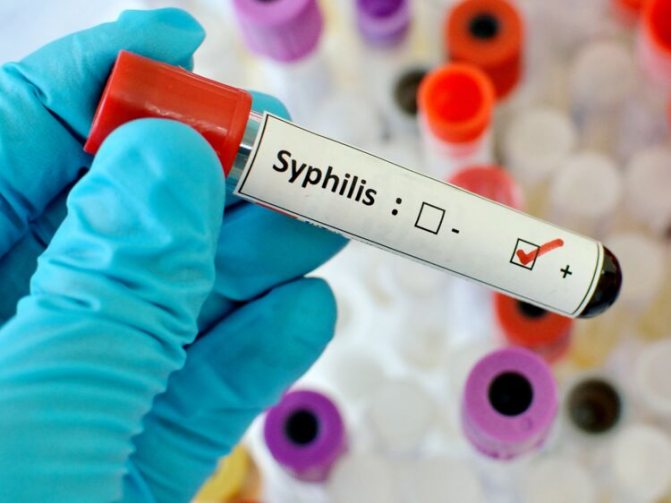
Positive reactions appear in many other diseases and conditions of the body.
There are three groups of reasons for these results:
1. Infections.
2. Other pathological and physiological conditions that change metabolism.
3. Technical errors during the test.
The main pathologies that cause false-positive RPR:
- tuberculosis;
- cancer;
- autoimmune pathologies (including phospholipid syndrome, rheumatoid arthritis, dermatomyositis, etc.);
- infection with other types of treponemas;
- viral hepatitis;
- viral pneumonia;
- Infectious mononucleosis.
Positive results may occur during pregnancy.
They are also often observed in patients with dysmetabolic diseases.
Causes may include gout and diabetes.
False-positive reactions are observed with constant use of drugs and alcohol.
False positive RPR results also occur when the diagnosis is performed incorrectly.
The most common cause is drying of the test components on the glass slide at high temperatures.
It is recommended to place the slide under a moisturizing coating.
Otherwise, agglutination may occur, which will be considered a positive RPR result by the technician.
To minimize the risk of error, the reliability of the results is confirmed by the use of control samples (positive and negative).
False negative test for syphilis RPR
RPR very rarely barks false negatives.
Because the test is highly sensitive.
But sometimes this happens.
The most common cause is too high a level of antibodies.
In this case, the “prozone phenomenon” is observed.
The result will be negative when whole serum is used for diagnosis.
If you dilute it, the concentration of antibodies will decrease.
Then the result will already be positive.
Other reasons for a negative result in a person suffering from a syphilitic infection:
- too little time has passed since infection;
- there are disturbances in the functioning of the immune system (HIV and other immunodeficiencies);
- the duration of the disease is 3-4 years or more.
When to get tested for syphilis RPR after infection
RPR becomes positive after infection 1-2 weeks after the onset of primary syphiloma.
It is advisable to get tested no earlier than 5 weeks after possible infection.
Otherwise, the risk of a false negative result will be high.
The more time has passed since infection, the more accurate the RPR results will be.
3 weeks after infection, reagin antibodies will be detected in the blood of 60-70% of patients.

After 5 weeks, the sensitivity of the test increases to 80% or more.
Gradually it approaches 100%, reaching this mark in the secondary period of the disease.
general characteristics
Treponema pallidum has several antigens that cause the production of antibodies. One of them is similar to cardiolipin, which allows the latter to be used to detect immunity to treponema pallidum. RPR is a screening anticardiolipin test (non-treponemal) for detecting antibodies (reagins) of the IgG and IgM class to lipoid and lipoprotein-like material released from damaged cells of a patient with syphilis. Antibodies are detected in 70 - 80% of people with primary syphilis and in almost 100% of patients with secondary and early latent syphilis. In most cases, a positive RPR reaction is observed 7 - 10 days after the appearance of primary chancre or 3 - 5 weeks after infection, then titers decrease. About 30% of patients with late syphilis become non-reactive on the RPR test. A decrease in RPR titer by 4 or more times within 1 year after therapy confirms its effectiveness. In 90 - 98% of cases after treatment of syphilis, the result of the RPR test becomes negative. The test is not specific, so false-positive reactions may occur. Antilipoid antibodies can appear frequently in autoimmune diseases. If a positive result is obtained in the RPR test, the patient should be examined by a dermatovenerologist with an additional blood test - antibodies to Treponema pallidum IgG/IgM. These two studies are complementary; the combination of RPR and the IgG, IgM ELISA test represents the best screening test for detecting or excluding syphilis at all stages.
Analogues of the RPR test for syphilis
RPR is aimed at detecting reagins in the blood.
There are other methods for their determination.
Although earlier tests may have slightly less sensitivity.
Other non-treponemal tests that are analogues of RPR:
- microreaction of precipitation;
- VDRL (the most commonly used test in Western countries);
- CMF;
- USR;
- ART;
- complement fixation reaction (Wassermann);
- sedimentary reactions (Kahn, Sachs-Vitebsky).
In Russian clinics, RPR and PB (Wassermann reaction) are most often used as screening reactions.
The first one is more accurate.
It also makes it possible to determine the antibody titer.
That is, quantitative indicators that allow tracking the dynamics of the disease.
An increase in titer indicates the progression of a syphilitic infection.
While a decrease in the number of antibodies by 4 times or more over the course of a year is an argument in favor of the success of the therapy.
What tests to take for syphilis if RPR is positive?
If positive reactions are obtained from screening tests during the initial diagnosis of syphilitic infection, the patient undergoes treponemal studies.
That is, serological tests that are aimed at detecting antibodies to the pale spirochete.
ELISA, RIF, RIBT, RPGA can be used as confirmatory tests.
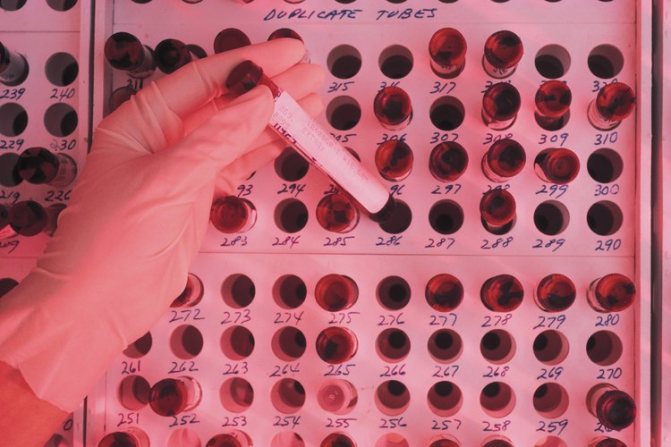
They are performed in the following cases:
- positive RPR result in pregnant women;
- positive RPR in individuals without symptoms of syphilis;
- negative RPR in patients with symptoms of syphilitic infection.
All of these methods have higher specificity.
They make it possible to determine total antibodies or immunoglobulins of individual classes.
In practice, IgM and IgG are determined.
The first group of antibodies appears in a short time after infection (after 2 weeks), then quickly disappears from the blood.
IgG appears a month after infection.
But these antibodies remain in the blood throughout the entire period of the disease and even after the pathology has been cured.
Titers can reach significantly higher values than the amount of IgM.
Sometimes the determination of IgM alone is crucial in diagnosis.
For example, when examining for a syphilitic infection in a short time after infection.
Or to diagnose syphilitic infection in newborns.
IgG can enter their blood through the mother's placenta.
Therefore, the presence of such antibodies does not mean that the child is sick.
But the presence of IgM confirms the diagnosis.
These antibodies have larger molecular sizes.
They do not pass through the placenta.
Therefore, the appearance of IgM in a child indicates that it was his own body that synthesized immunoglobulins in response to the penetration of the pale spirochete into the body.
How the RPR test for syphilis works
The blood test for syphilis rpr, as doctors note, works very simply.
The reaction is based on a combination of antigen and antibody.
Antigen is any substance foreign to the human body that has entered it from somewhere outside. The human body naturally considers such antigens hostile and begins to deploy a defense system against them.
An antibody is a weapon of the immune system in the fight against antigens, to put it simply. It is these substances that the body produces when pathogenic microorganisms enter it, including Treponema pallidum.
There are two types of antibodies.
The former can react to several types of antigens at once. It turns out that they provide protection against several antigens at once.
On the other hand, there are very highly specialized antibodies that are produced only in response to the body coming into contact with certain antigens.
The essence of the study is very simple. Blood is taken from the patient and mixed with antigens that belong to Treponema pallidum. Both artificial and natural antigens can be used. If there are antibodies to the pathogen in the patient’s circulatory system, a reaction will occur with the formation of a precipitate.
If there are no antibodies, there will be no reaction, which means, ideally, there is no disease either.
Where to go if you test positive for syphilis
If a person has been tested for syphilis and they are positive, you need to consult a venereologist.
The doctor will conduct an additional examination of the patient and then prescribe treatment.
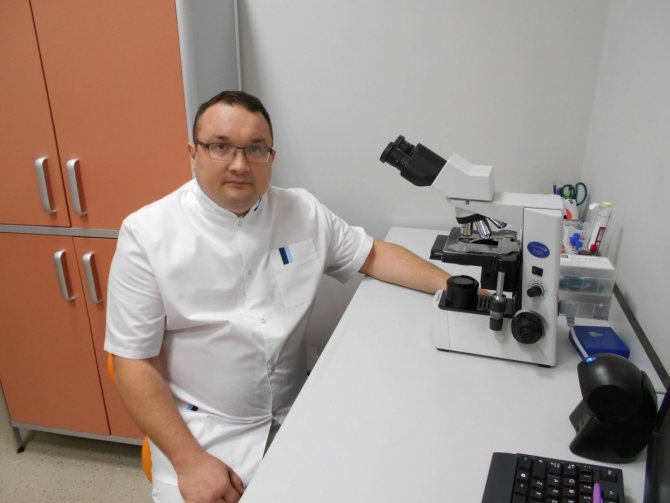
Diagnostic measures are necessary to:
- make sure that the patient has syphilis;
- establish the duration of infection and the prevalence of infection, as this affects the choice of therapeutic tactics, regimen and duration of antibiotic therapy;
- identify concomitant sexually transmitted infections or HIV.
After making a diagnosis, the doctor immediately prescribes treatment.
The earlier therapy is started, the more successful it will be.
In addition, the smaller doses of antibiotics can be used, the less often you will have to give injections and the shorter the course will be.
If the disease is detected in the primary period, a person is given long-acting penicillin injections only 1-2 times a week.
The course lasts 3 weeks.
But already in the tertiary period, therapy is carried out in a hospital setting.
A person undergoes 2 courses of 20 days.
Antibiotics are administered intramuscularly or intravenously every 6-8 hours.
Therefore, in every sense, it is more beneficial for the patient to seek help as early as possible.
This will save time, money and health, improve treatment tolerance and reduce the risk of hospitalization in a sexually transmitted disease hospital.
When do doctors recommend getting tested?
In modern clinics, non-treponemal tests are prescribed to all patients who visit a doctor for the first time to identify an infection or who undergo mandatory medical monitoring. These tests can also be effective in identifying specific symptoms and signs of the early stages of syphilis.
In most patients with clinical symptoms of the first and second stages of syphilitic infection, the result of non-treponemal tests is positive in 87-95% of cases, which is a fairly large indicator. The sensitivity of the reaction can be somewhat reduced only in the very early stages of the disease, however, with the onset of primary manifestations, the accuracy of the method increases to 96%. Such high rates make the test for syphilis RPR, the RPR method, and also the test for syphilis using the RPGA method universal primary diagnostic complexes for all patients. That is why venereologists often begin an examination by prescribing these tests for the patient.

When to get tested for syphilis RPR after treatment
RPR has a significant advantage over treponemal tests.
It lies in the fact that reagin antibodies disappear in 90-98% of patients (depending on the period of the disease) after a course of therapy.
Thus, based on the results of RPR, it is possible to confirm that a person is cured.
At the same time, treponemal tests are not used for this.
Because they remain positive for many years after treatment.
In some cases, the results of such studies are never negatived at all.
When RPR is prescribed after treatment depends on at what stage syphilis was identified and treated.
If preventive therapy was carried out, or symptoms of the disease appeared, and tests for antibodies did not have time to become positive, the control is performed once.
RPR is taken 3 months after taking the last dose of the antibacterial drug.
If the result is negative, the person is not subject to further observation.
If the patient has been diagnosed with early syphilis, and antibodies have already appeared in the blood, he is monitored for much longer.
Every 3 months he takes the RPR until a negative result is obtained.
And after this happens, the observation period is another 6 months.
After this period, another control is carried out.
If the RPR is again negative, the person is removed from the register.
People with late syphilis (infected more than 2 years ago) are observed for at least 3 years.

RPR is done every 6 months.
Additionally, treponemal studies are performed every 12 months.
In case of neurosyphilis, liquorological control is carried out.
Seroresistance in syphilis
Sometimes RPR remains positive in treated patients.
There is no significant decrease in antibody titer.
But this is not always confirmation of unsuccessful therapy.
Sometimes a phenomenon called seroresistance is observed.
This means that a patient who has had syphilis continues to have positive reactions, despite the absence of the disease.
Criteria by which treatment results are assessed as good:
- RPR negation;
- decrease in antibody titer within 1 year by 4 times or more;
- decrease in the degree of reaction from positive to slightly positive.
If the RPR is negative, the issue of deregistration is considered.
In the remaining two cases, observation continues.
If the titer does not decrease or increases, an additional course of antibiotic therapy is indicated.
Thus, the results of RPR after treatment allow:
- evaluate the success of therapy;
- decide on the need for additional treatment;
- establish the patient’s cure;
- remove it from the register.
No decisions are made based on the RPR alone.
Additionally, other studies are needed.
Treponemal tests are performed.
A cerebrospinal fluid examination is performed if neurosyphilis has been diagnosed.
A number of specialists examine the patient to identify disorders of various organs and systems.
At a minimum, he is examined by an ophthalmologist, a neurologist, a venereologist and a therapist, and, if necessary, other doctors.


